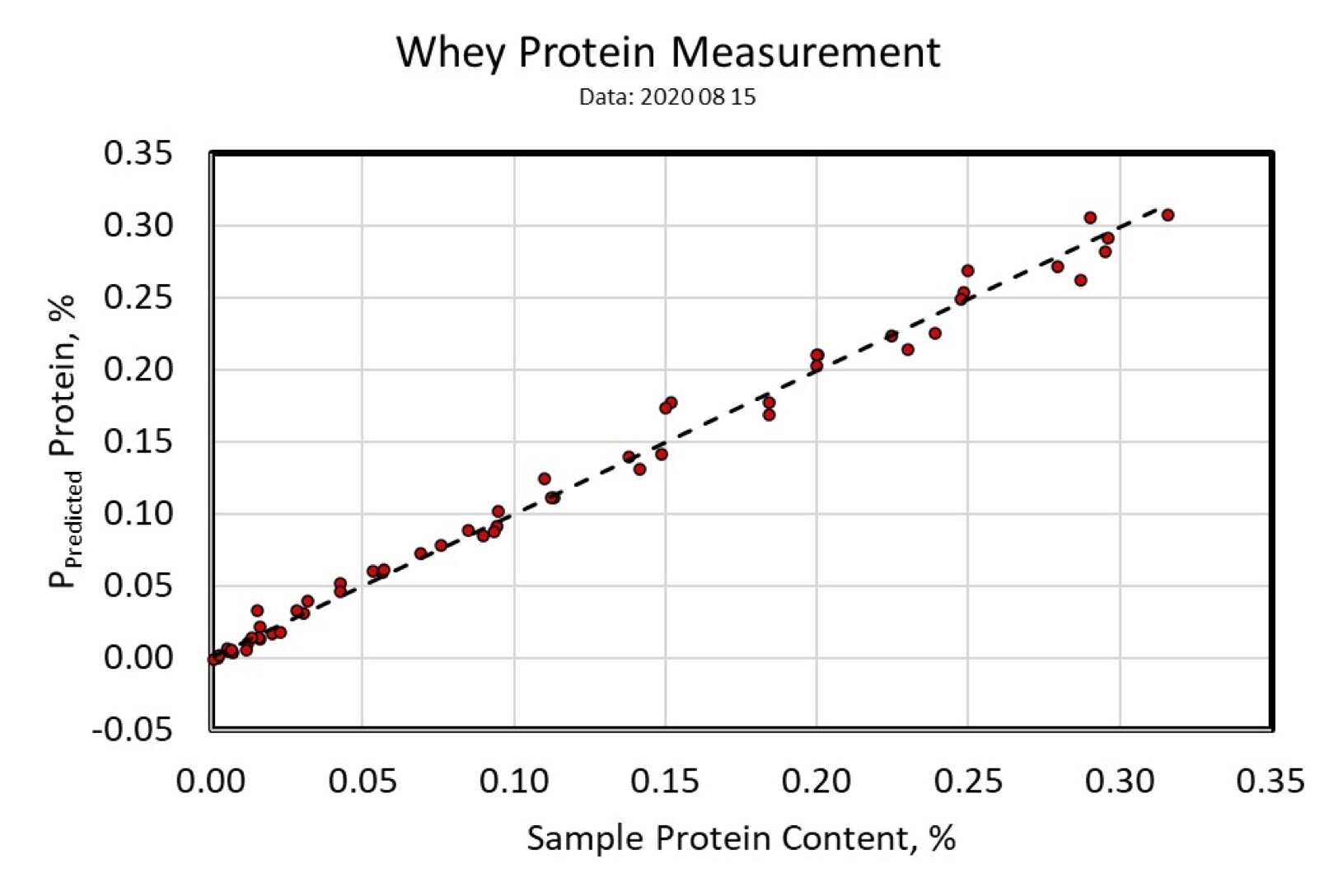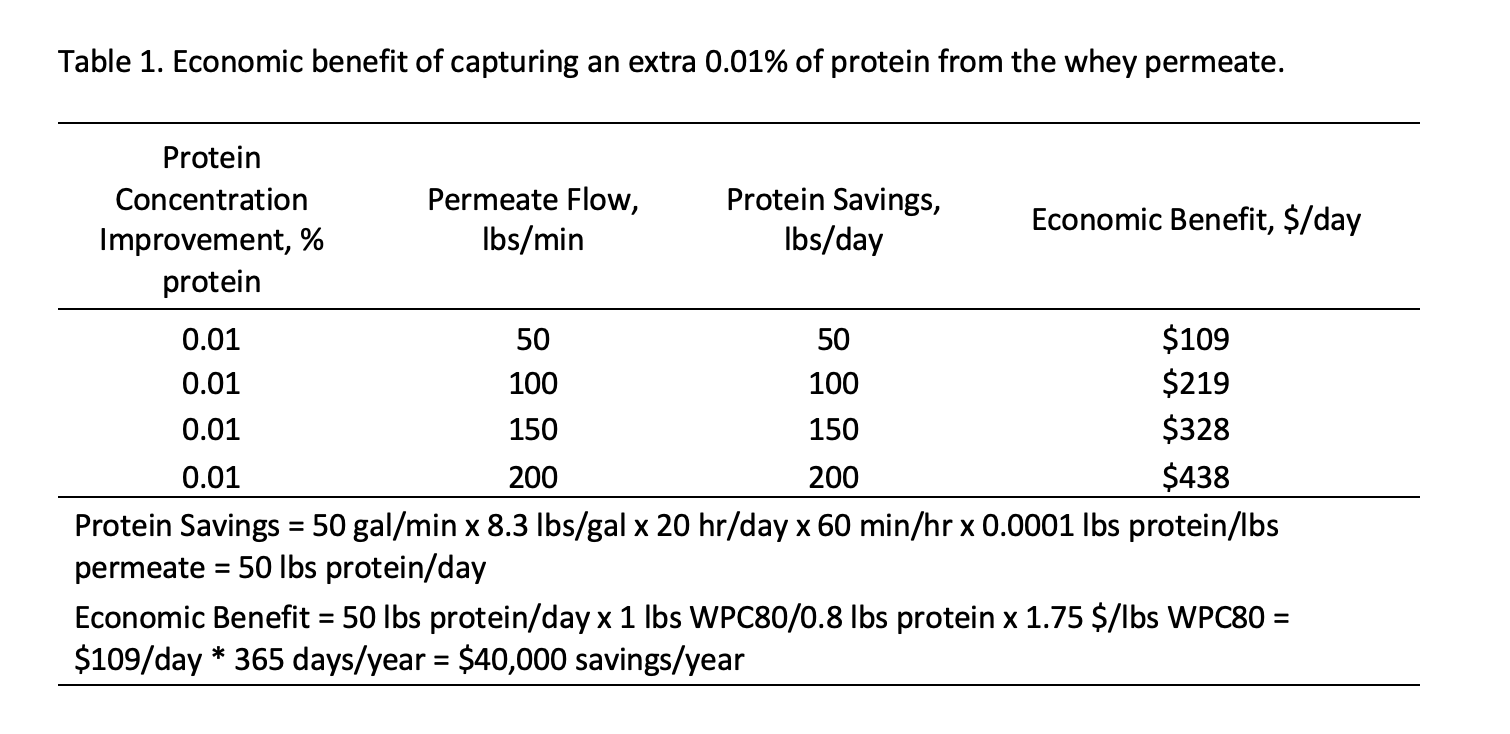FluorLite-LX
Fluorescent Sensor Technology for Measuring True Protein Concentration in Whey Permeate
Summary
Membrane filters used in the dairy industry to separate whey proteins from whey have a definite lifetime with protein losses increasing as the filters degrade. The FluorLite-LX sensor was developed to measure true protein concentration in whey permeate and assist the determination of membrane filter performance.
The FluorLite-LX fluorescent sensor technology measures true protein by directing ultraviolet light into a whey protein solution, exciting the amino acid tryptophan, and measuring the generated fluorescent intensity. An algorithm uses fluorescent intensity measurements to determine the true protein concentration of the solution corrected for temperature and solids concentration.
The inline FluorLite-LX sensor measures the true protein concentration in real-time with a precision of 0.01% over a calibrated range of 0 to 0.30% protein. The measured protein concentration information can be used to monitor filter performance, provide a threshold alert for excess leakage, and facilitate filter replacement decisions.
Fluorescent Measurement Technology
The current method for measuring protein concentration in whey permeate is to manually collect samples and use FTIR or similar analytical instruments to measure the “Total Protein.” For whey permeate, this “Total Protein” measurement includes a significant quantity of non-protein nitrogen (NPN). Typically, whey permeate samples consists of 75% NPN and 25% true protein but the composition varies with the filtration process. Thus, measurement of “true” protein concentration would provide a more precise and economically valuable measure of membrane filter performance.
The fluorescence measurement technology takes advantage of the natural fluorescence of proteins in whey permeate to measure true protein. Three aromatic amino acids (tryptophan, tyrosine, phenylalanine) fluoresce when excited with ultraviolet light. The fluorescence of dairy proteins is dominated by tryptophan fluorescence. Dairy proteins contain 2-3% tryptophan. Tryptophan fluorescence is generated by ultraviolet light at 280 nm and the fluorescence spectra has a peak at about 350 nm. NPN does not fluoresce and thus is not measured. Figure 1 shows the spectral measurement of a 280 nm UVLED and the fluorescent emissions of milk proteins.
Figure 1. Spectral emissions from skim milk showing both the LED excitation and fluorescent emissions.
Front Face Technology
The sensor technology selected for this application uses front face fluorescence. The sensor consists of optical bundles of fibers that direct 280 nm excitation light from an UVLED through a sapphire window into the whey permeate solution containing fluorescent compounds. The resulting fluorescence is likewise directed to a photodetector using optical fibers.
Protein Measurement Range
The true protein concentration of a whey permeate solution is generally desired to be less than 0.05% and anything over 0.30% would indicate excessive leakage. The FluorLite-LX is typically calibrated to the range of 0.01 to 0.30% and has a precision of 0.01% true protein.
Soluble Solids Concentration
Whey permeate contains soluble solids composed primarily of lactose (75%) with smaller quantities of protein, non-protein nitrogen compounds, organics, and minerals (calcium, phosphorus, sodium, potassium, chloride). The typical range for soluble solids concentration in whey permeate varies from 1 to 9% depending on the filtration process. As whey permeate solids increase, the measured fluorescence decreases because the solids absorb and scatter the fluorescent light. This effect is called fluorescent light extinction and results from a combination of absorption, scattering, and quenching of the fluorescent light.
Light Extinction Measurement
The FluorLite-LX takes two measurements: one measures fluorescent intensity and the other measures light extinction. These two measurements are related using an algorithm to provide a measure of true protein.
Measurement Precision
The precision of the sensor was tested by collecting whey permeate samples, sending to a lab for protein and solids content, and mixed to create 56 test samples having solids between 1 and 10% and true protein between 0.01 and 0.35%. True protein concentrations and the sensor’s predicted true protein concentrations are shown in Figure 2. The SEP (standard error or prediction) for the data was 0.01% true protein. This data demonstrated the ability of the FluorLite-LX sensor to measure true protein content of whey permeate at low concentration corrected for solids content.
Figure 2. Plot of algorithm model: predicted true protein concentration as a function of sample true protein concentration.
FluorLite-LX Sensor
The inline FluorLite-LX sensor has a 2” Tri Clamp connection and outputs a 4-20 mA signal linearly proportional to the true protein content of the whey permeate solution.
Figure 3. FluorLite-LX sensor showing 2” Tri Clamp connection to a short Tee, a temperature probe and sapphire window on the probe face, a 5-wire instrument connection, and a picture of a prototype sensor installed in a dairy plant.
Economic Benefit
The potential economic benefit of capturing an extra 0.01% protein from the whey permeate using a FluorLite-LX sensor is shown in Table 1. For example, if the permeate flow is 50 gallons per minute and the protein concentration can be reduced by 0.01% then there is a daily savings of $109 and a yearly savings of about $40,000.
FluorLite-LX Fluorescent Sensor Technology for Measuring True Protein Concentration in Whey Permeate
Written by Frederick A. Payne and Samuel J. Mullins
Reflectronics, Inc.
Email: info@reflectronics.com
Last updated June 10, 2021




